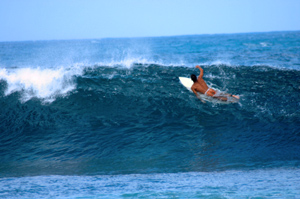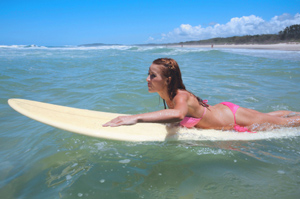How to Paddle and Maneuver a Surfboard
If you clicked on this guide expecting to read nothing more than a sentence or two briefly describing the correct paddling motion, well, you’re going to have to reassess the situation. Go ahead and tell your secretary to hold your calls for the afternoon – you have some catching up to do.

Learning to paddle correctly – and later practicing and building arm strength – are essential requisites towards becoming a competent surfer. It isn’t particularly difficult or glamorous, but strong paddling will allow you to better position yourself for waves, and catch them once you’re in the lineup.
Paddle Grounds
Before you even hit the water, you’re going to need to find a good place to learn how to paddle your surfboard. Windy conditions, large surf, crowds, and rip currents will all inhibit your ability to paddle around comfortably. Your ideal paddle scenario is one that doesn’t have any of those factors; instead, look for conditions with small waves, little or no wind, no crowds, and no rips. Yep, you can learn to paddle in a lake.
Body Positioning
In order to maximize your speed, it’s important to understand the basic dynamics behind paddling a surfboard. Like any water craft, the more surface area of the surfboard that touches the water, the more speed you’re going to be able to generate. Your goal when paddling is to help the board glide over the water’s surface. Keeping that in mind, position yourself on the surfboard so that most of the board’s bottom surface area is in contact with the water. Your chest should lie somewhere near the top 1/3 of the board, causing the nose of the board to protrude no more than a few inches above the water’s surface.

Many beginner surfers lie too far back on the board, causing the tail to sink below the surface and the nose to pop high out of the water. This will significantly hinder your paddling ability, as the board will be dragging through the water rather than gliding over it. Position yourself too far forward, and your nose will dive under the surface, causing you to fall over the front of the board.
Another important paddling key is body posturing. Keep your chest up high off the board at all times. Although it might feel more natural at first, do not lie flat with your chest on the surfboard. Paddling with your chest high will allow you to pull more water, thus maximizing the power of your arm strokes.
Paddling Technique
Keeping your chest elevated, paddle alternately with both arms in a similar motion to the forward crawl. Your arms should be bent at the elbow in a 90-degree angle; this will allow you to pull a lot of deep water. Once you’re able to paddle comfortably, keep working on your technique to build up muscle in your chest, arms and shoulders.
Mission Control
Now that you’ve got the hang of paddling your surfboard, you’re ready to take on the first phase of the surfing experience: the paddle out.
To get yourself in the right mindset for the paddle out, it helps to understand exactly what your goal is at this point. Basically, you’re on a mission to get past the surf zone. Depending on the size of the surf and the availability of a channel, the difficulty of the paddle out can range from a near-impossible struggle to a mellow cruise toward the lineup.
Before you hit the water, assess the conditions and locate the best path to take past the surf zone. There may be an obvious channel, or you may be surfing a beach break that requires a bit of timing between sets. Whichever the case, be patient and make life easier by paddling out properly.
Life’s a Paddle
Once you’ve mastered your paddling technique and gained strength in the corresponding muscles, paddling will become second nature. You’ll rarely think about it, even if you spend 90% of every session doing it. Of course, there are always those days when the swell is pumping, the rip current is dragging you down the beach and there’s only one thing you can do: keep paddling.
